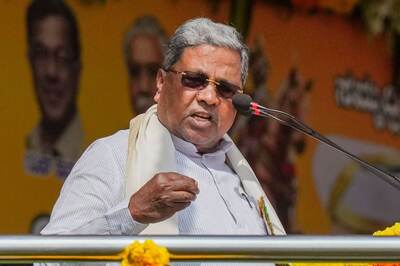
views
Washington: Better. The job market beat expectations, and the stock market managed a modest gain - not great, but good enough after a turbulent week. The nation added 117,000 jobs in July, the government said on Friday - far from what happens in a healthy economy, and only good for a reduction of one notch in the unemployment rate, to 9.1 per cent.
But the jobs number beat the forecast of economists, who were expecting no more than 90,000. And it was an overwhelming relief for investors, who just lived through two of the most brutal weeks in Wall Street history.
"Nothing to pop Champagne corks over," said Diane Swonk, chief economist at Mesirow Financial, "but a much-needed shot in the arm for confidence at a time when we have so little."
But when they come back on Monday, investors will have to absorb another body blow - Late on Friday, ratings agency Standard & Poor's downgraded the United States' debt for the first time, saying the government's debt-reduction plans fall short. The downgrade could lead to higher interest rates and further hamper the economic recovery.
The Dow Jones industrial average finished on Friday with a gain of 60.93 points and closed at 11,444.61. It made up only a small fraction of the losses from Thursday, when the Dow dropped 512, its worst since the financial crisis of 2008.
Friday was not exactly quiet for the market, either.
At the start of trading, investors were thrilled with the unemployment report, and the Dow rose 171. Ten minutes later, the gains were gone. Investors focused on Europe, which is struggling to keep Italy and Spain from being consumed by a growing financial crisis, and the Dow fell 243.
"The fear was that they had no plan to deal with the situation," said Randy Warren, chief investment officer at Warren Financial Service.
Later in the day, Italy promised to work toward a constitutional amendment to balance its budget. It was trying to calm investors around the world, who are worried that financial problems are spreading in Europe.
The Dow's gain was only its second in the past 11 trading sessions. The average has lost about 10 per cent of its value in that time. The Standard & Poor's 500, a broader measure of the market, finished just under 1,200, down a fraction of a point.
It was the Dow's worst week since March 2009, down 5.8 per cent. The S&P, down 7.2 per cent, and the Nasdaq composite index, down 8.1 per cent, had their worst weeks since November of that year.
The gain of 117,000 jobs for the US economy looked even better considering that 37,000 public jobs disappeared during the month. Most of those were from a temporary government shutdown in Minnesota.
Subtracting those government layoffs, the private sector added 154,000 jobs for the month. And the economy added 56,000 more jobs than first thought in May and June.
Workers were paid more, too. Average hourly wages showed the biggest monthly gain since 2008. More jobs and better pay means people have more cash to spend, helping the economy grow.
And manufacturing companies added 24,000 jobs, which suggests that the supply disruptions caused by the Japan earthquake may be almost over. Makers of cars and other products found themselves short of parts after the disaster.
All told, the figures suggested a slower-growing economy - but not one on the verge of a new recession, as some had feared.
Some economists were impressed that the economy managed to add more than 100,000 jobs in a month when companies feared the government might default on its debt. Congress and the White House struck a deal with hours to spare.
Other economists noted that corporations remain highly profitable, stocked with cash, and can hire when needed. They're waiting for customer demand to come back in force.
The economy is still too weak to produce the 250,000 new jobs a month that it takes to bring down the unemployment rate quickly. The rate has been above 9 per cent in every month except two since the Great Recession ended in June 2009.
Other recent data show the economy struggling. In June, consumers cut back on spending for the first time in 20 months. Manufacturers are barely increasing their output. The economy barely grew in the first half of the year.
The weakness has raised pressure on the Federal Reserve to take further steps to support growth. After they meet on Tuesday, Fed policymakers could make clear that short-term interest rates will stay low indefinitely. But analysts say the Fed probably won't signal any new action.
The July job gains ranged broadly across industries. Retailers, factories and health care firms were among the many sectors that added workers.
President Barack Obama used the jobs report to press Congress to extend a Social Security tax cut enacted this year that put an extra $1,000 to $2,000 in most workers' pockets. Obama also called for a renewal of emergency unemployment benefits, which provide up to 99 weeks of support.
The tax cuts and extra benefits are scheduled to expire at year's end. Economists have cautioned that the end of the two programs could weaken growth in 2012.
Economists aren't expecting much improvement this year. Tom Porcelli, chief US economist at RBC Capital Markets, foresees growth at a modest 2.4 per cent annual rate in the last six months - the same as he did before Friday's jobs report.
"These numbers are not great," Ian Shepherdson, an economist at High Frequency Economics, said in a note to clients. "But they are a long way from recession territory."
Dan Schneider, founder of SIB Consulting and Development in Charleston, SC, started hiring one or two employees a month earlier this year. He plans to keep doing so for the next year to year and a half.
Business clients pay Schneider's firm to look over their bills and find savings. The company keeps a cut. Schneider started the company during the recession and now employs about 25 people.
"The economy is not that great, and people are looking to save money," he said. "We find people more receptive to what we do."
Unemployment came down partly because some people stopped looking for work. Those people are no longer counted as unemployed. There are about 13.9 million people unemployed in the United States, double the total before the recession.
The number of people working part time who would prefer full-time work declined. Adding them to people who are unemployed or have given up looking, 25.1 million people are "underemployed," about 16 per cent of the work force.


















Comments
0 comment